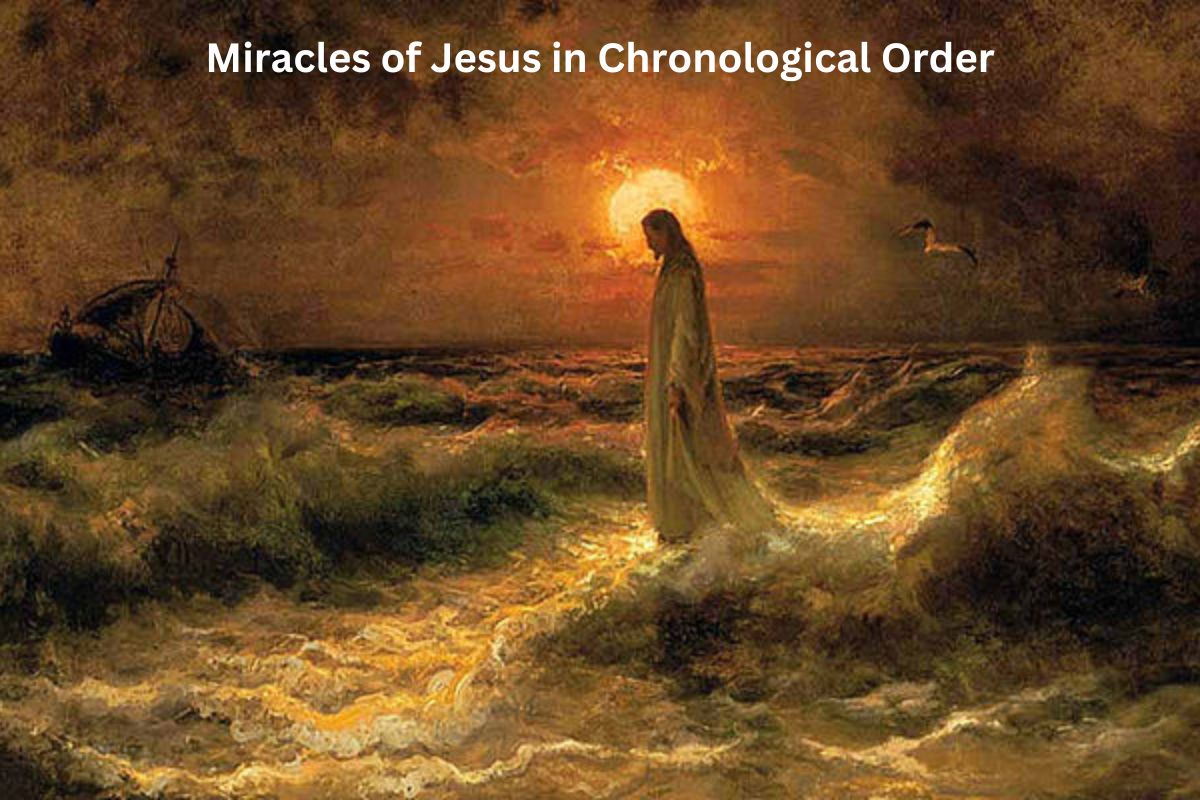The miracles of Jesus, as recorded in the New Testament, form a central and captivating aspect of His ministry.
These extraordinary acts of divine power serve not only as demonstrations of compassion and healing but also as powerful affirmations of His identity as the Son of God and the promised Messiah.
From turning water into wine at a wedding in Cana to raising the dead and feeding multitudes with a few loaves and fish, each miracle tells a unique story of faith, compassion, and transformation.
In this exploration, we delve into the chronological account of these remarkable events, unraveling the significance and lessons embedded within them.
| Miracle | Scripture Reference | Description |
|---|---|---|
| Turning Water into Wine | John 2:1-11 | Jesus turned water into wine at a wedding in Cana. |
| Healing the Nobleman’s Son | John 4:46-54 | Jesus healed a royal official’s son from a distance. |
| Healing the Paralyzed Man at the Pool of Bethesda | John 5:1-9 | Jesus healed a man who had been paralyzed for 38 years. |
| Feeding the 5,000 | Matthew 14:13-21, Mark 6:30-44, Luke 9:10-17, John 6:1-15 | Jesus miraculously multiplied loaves and fish to feed a large crowd. |
| Walking on Water | Matthew 14:22-33, Mark 6:45-52, John 6:16-21 | Jesus walked on the Sea of Galilee during a storm. |
| Healing the Syrophoenician Woman’s Daughter | Matthew 15:21-28, Mark 7:24-30 | Jesus healed the daughter of a Gentile woman. |
| Healing the Deaf and Mute Man | Mark 7:31-37 | Jesus healed a man who was both deaf and mute. |
| Feeding the 4,000 | Matthew 15:32-39, Mark 8:1-10 | Jesus again miraculously multiplied loaves and fish to feed a large crowd. |
| Healing the Blind Man at Bethsaida | Mark 8:22-26 | Jesus gradually restored the sight of a blind man. |
| Healing the Man Born Blind | John 9:1-41 | Jesus gave sight to a man who had been blind from birth. |
| Raising Lazarus from the Dead | John 11:1-44 | Jesus raised Lazarus, who had been dead for four days. |
| Cursing the Fig Tree | Matthew 21:18-22, Mark 11:12-14, 20-25 | Jesus cursed a fig tree, which withered. |
| Healing the Woman with the Issue of Blood and Raising Jairus’ Daughter | Matthew 9:18-26, Mark 5:21-43, Luke 8:40-56 | Jesus healed a woman with a hemorrhage and raised Jairus’ daughter from the dead. |
| Healing the Ten Lepers | Luke 17:11-19 | Jesus cleansed ten lepers, and only one returned to give thanks. |
| Healing the Man with a Withered Hand | Matthew 12:9-14, Mark 3:1-6, Luke 6:6-11 | Jesus healed a man with a withered hand on the Sabbath. |
| Feeding the 5,000 (Second Occurrence) | Matthew 15:32-39, Mark 8:1-10 | A second feeding miracle involving a different group of 5,000 people. |
| Casting out a Demon from a Boy | Matthew 17:14-21, Mark 9:14-29, Luke 9:37-43 | Jesus cast out a demon that had caused a boy to have seizures. |
| Healing the Blind Bartimaeus | Matthew 20:29-34, Mark 10:46-52, Luke 18:35-43 | Jesus restored the sight of a blind man named Bartimaeus. |
Chronological Order of the Miracles of Jesus
1. Turning Water into Wine (John 2:1-11):
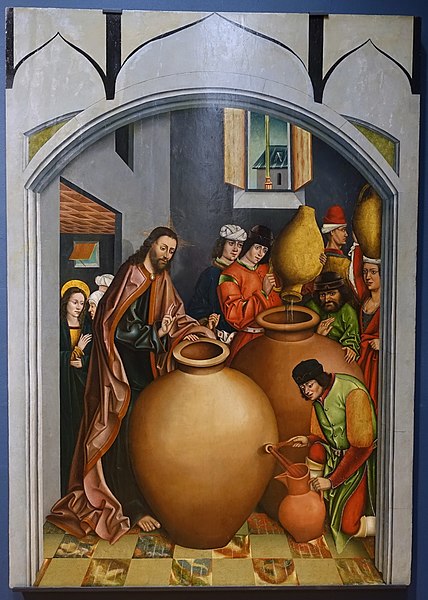
At a wedding in Cana, Jesus and his disciples were invited to celebrate. During the festivities, the wine ran out, which was a significant social embarrassment.
Mary, Jesus’ mother, informed him of the problem, and despite Jesus initially saying, “My hour has not yet come,” she instructed the servants to do whatever he told them.
Nearby, there were six stone jars used for Jewish purification rituals, each holding about 20 to 30 gallons of water.
Also Read: Timeline of the Book of Acts
Jesus instructed the servants to fill these jars with water, and then, after they did so, he told them to draw some out and take it to the master of the feast.
When the master tasted the water that had become wine, he remarked that it was the best wine, contrary to the usual practice of serving the best wine first.
This miracle is significant not only for its supernatural nature but also because it revealed Jesus’ divine authority and his willingness to meet people’s needs.
2. Healing the Nobleman’s Son (John 4:46-54):
In Cana of Galilee, a nobleman approached Jesus and pleaded for him to come to Capernaum and heal his son who was at the point of death.
Jesus, instead of going with the nobleman, told him, “Go; your son will live.” The nobleman believed Jesus’ words and returned to Capernaum.
Also Read: Timeline of the Canonization of the Bible
On his way home, the nobleman’s servants met him and informed him that his son’s fever had left him at the exact hour when Jesus had said, “Your son will live.”
The nobleman and his entire household believed in Jesus as a result of this miraculous healing.
This miracle showcases Jesus’ ability to heal from a distance and the importance of faith in his miracles.
3. Healing the Paralyzed Man at the Pool of Bethesda (John 5:1-9):
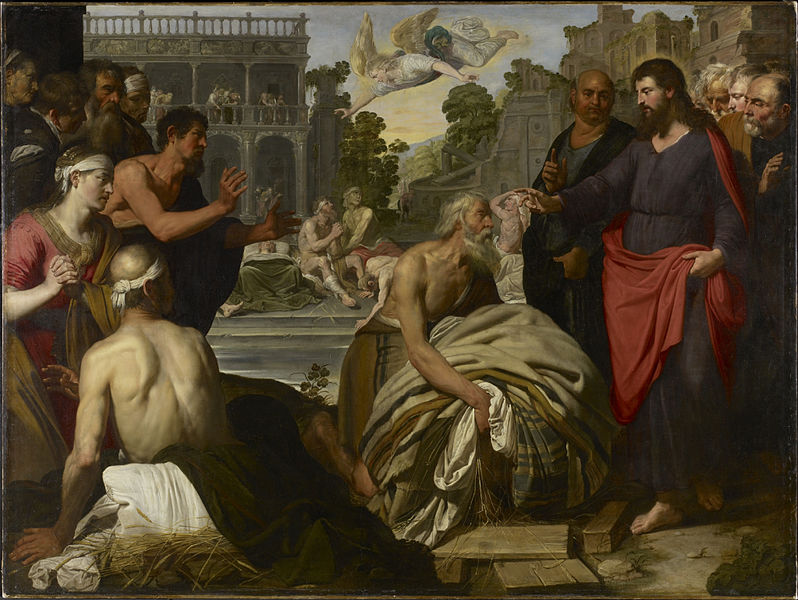
In Jerusalem, there was a pool called Bethesda, near the Sheep Gate, with five covered colonnades.
A multitude of sick, blind, lame, and paralyzed people would gather there because they believed that at certain times, an angel would stir the waters, and the first person to step in after the stirring would be healed.
Among the crowd, there was a man who had been paralyzed for 38 years.
Jesus approached the man and asked if he wanted to be healed. The man explained that he had no one to help him into the pool when the water was stirred.
Jesus then simply said, “Get up, take up your bed, and walk.”
Instantly, the man was healed, and he picked up his mat and walked.
This miracle demonstrated Jesus’ compassion for the suffering and his authority over sickness and disability.
4. Feeding the 5,000 (Matthew 14:13-21, Mark 6:30-44, Luke 9:10-17, John 6:1-15):
This miracle is one of the most famous in the Bible and is recorded in all four Gospels.
Jesus had been teaching a large crowd in a remote place, and as evening approached, the disciples were concerned about how to feed the hungry crowd.
With only five loaves of bread and two fish, Jesus took the food, blessed it, and broke it, then instructed the disciples to distribute it to the people.
Miraculously, the food multiplied, and there were twelve baskets of leftovers.
This miracle demonstrated Jesus’ divine power to provide for the physical needs of a multitude and foreshadowed his role as the Bread of Life.
5. Walking on Water (Matthew 14:22-33, Mark 6:45-52, John 6:16-21):
After feeding the 5,000, Jesus sent his disciples across the Sea of Galilee while he went up into the mountains to pray.
Later that night, a strong wind created rough seas, and the disciples’ boat was struggling against the waves. Jesus, walking on the water, came toward them, and they initially thought he was a ghost.
Jesus reassured them, saying, “It is I; do not be afraid.”
Peter, one of the disciples, asked to walk on the water too, and Jesus invited him out of the boat.
As long as Peter kept his eyes on Jesus, he was able to walk on the water, but when he became afraid and looked at the storm, he began to sink. Jesus rescued him.
This miracle showed Jesus’ power over the natural elements and encouraged faith, emphasizing the importance of keeping one’s focus on Him in the midst of life’s storms.
6. Healing the Syrophoenician Woman’s Daughter (Matthew 15:21-28, Mark 7:24-30):
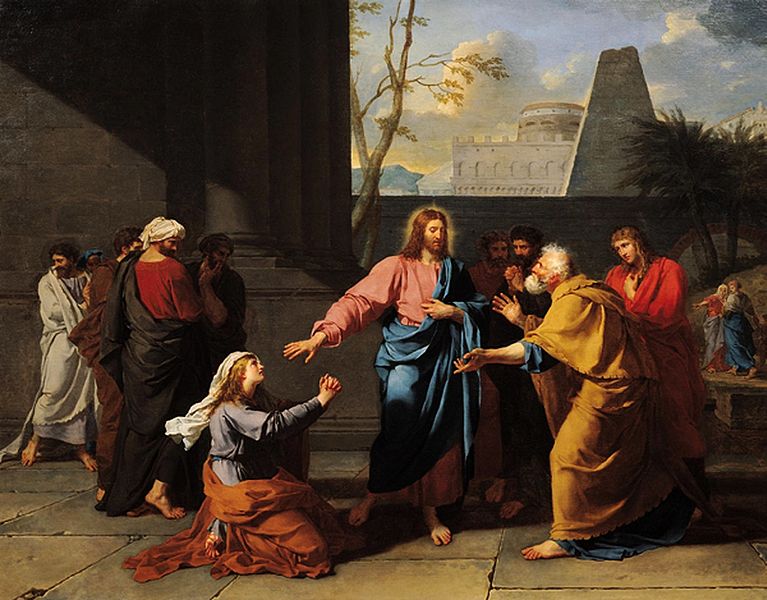
Jesus traveled to the region of Tyre and Sidon, which was outside of Jewish territory.
A Gentile woman of Syrophoenician origin approached Jesus, seeking help for her demon-possessed daughter.
Initially, Jesus seemed to decline her request, saying that he was sent to the lost sheep of Israel.
The woman, however, persisted, expressing her faith in Jesus by saying that even the dogs eat the crumbs that fall from their masters’ table.
Impressed by her faith, Jesus commended her and declared her daughter healed from that moment.
This miracle highlighted Jesus’ willingness to extend his ministry to Gentiles and the importance of persistent faith in seeking help from Him.
7. Healing the Deaf and Mute Man (Mark 7:31-37):
Jesus left the region of Tyre and Sidon and entered the region of the Decapolis, a Gentile area. A deaf and mute man was brought to Jesus by people who begged Him to lay His hand on him.
Jesus took the man aside privately, put His fingers in the man’s ears, spat and touched the man’s tongue, and then looked up to heaven and sighed.
He commanded, “Be opened,” and immediately, the man’s ears were opened, and his tongue was loosed, enabling him to speak.
Jesus instructed them not to publicize the miracle, but the people were astonished and couldn’t keep it a secret.
This miracle demonstrated Jesus’ compassion for those with disabilities and his authority over physical impairments.
8. Feeding the 4,000 (Matthew 15:32-39, Mark 8:1-10):
This miracle is similar to the feeding of the 5,000 but involves a different group of people.
A large crowd had gathered to hear Jesus teach in a desolate place, and they had been with Him for three days without food.
As in the previous miracle, Jesus felt compassion for the hungry crowd and wanted to feed them.
With seven loaves of bread and a few small fish, Jesus performed a similar act of multiplication, providing enough food for the crowd.
After everyone had eaten and was satisfied, seven baskets of leftovers were collected.
This miracle demonstrated Jesus’ consistent compassion for the physical needs of people and emphasized his ability to provide abundantly.
9. Healing the Blind Man at Bethsaida (Mark 8:22-26):
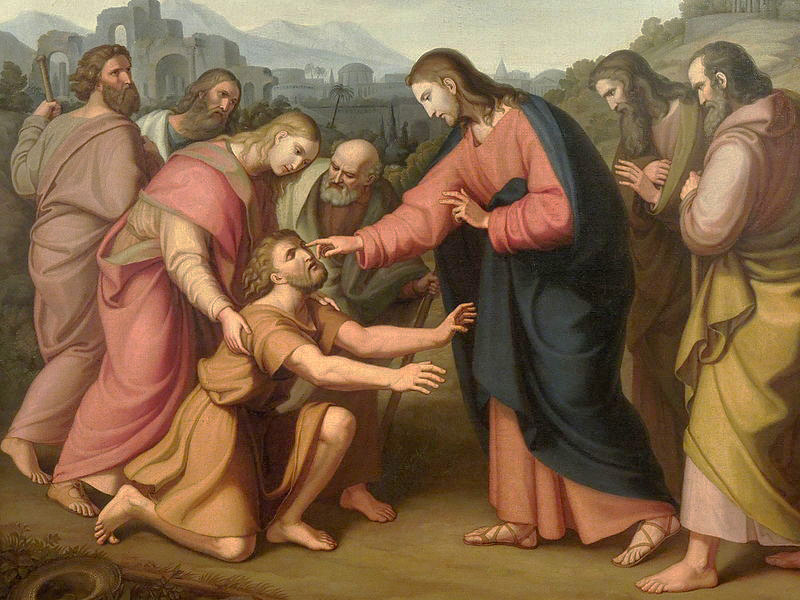
In Bethsaida, some people brought a blind man to Jesus and begged Him to touch the man.
Jesus took the blind man by the hand, led him out of the village, and then spit on his eyes and laid hands on him.
He asked the man if he saw anything, and the man replied that he saw people, but they looked like trees walking.
Jesus laid hands on the man’s eyes again, and this time, his sight was fully restored, and he could see everything clearly.
This miracle is unique in that it occurred in stages, illustrating Jesus’ healing power and his willingness to bring complete restoration.
10. Healing the Man Born Blind (John 9:1-41):
As Jesus was walking along, He and His disciples encountered a man who had been blind from birth.
The disciples asked whether the man’s blindness was due to his own sin or his parents’ sin. Jesus clarified that it was neither but that the works of God might be displayed in him.
Jesus then spat on the ground, made mud with His saliva, and applied it to the man’s eyes. He instructed the man to wash in the Pool of Siloam. After washing, the man was miraculously healed and gained his sight.
This miracle led to controversy and questioning by religious authorities, but it also served as a powerful testimony to Jesus’ identity as the Messiah.
11. Raising Lazarus from the Dead (John 11:1-44):
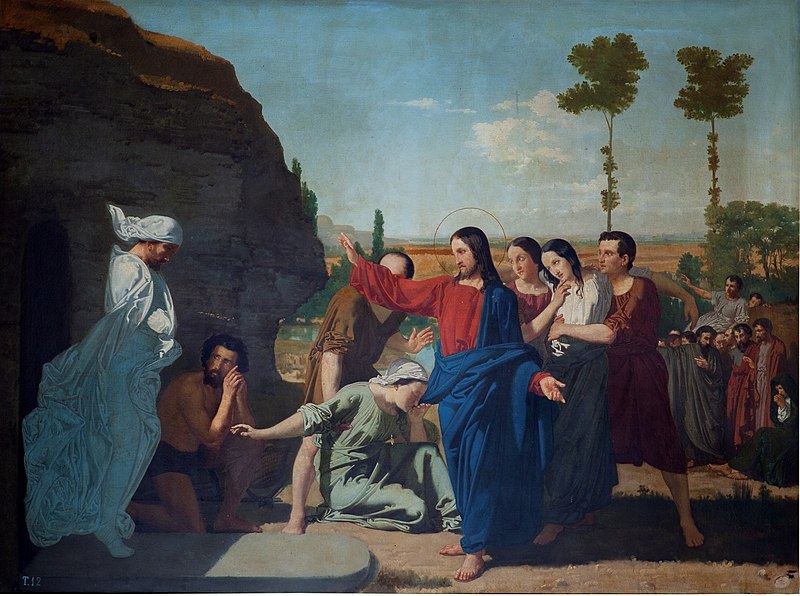
Lazarus, a close friend of Jesus, had fallen seriously ill, and his sisters, Mary and Martha, sent word to Jesus about his condition.
Jesus delayed his arrival intentionally, allowing Lazarus to die, stating that it was for the glory of God. When Jesus finally arrived at the tomb, Lazarus had been dead for four days.
He instructed that the stone covering the tomb be removed, and despite Martha’s initial concern about the smell of the decaying body, the stone was rolled away.
Jesus then called Lazarus by name, and Lazarus came out of the tomb, still bound in burial cloths.
This extraordinary miracle demonstrated Jesus’ power over death and was a pivotal event that intensified opposition against Him from religious authorities.
12. Cursing the Fig Tree (Matthew 21:18-22, Mark 11:12-14, 20-25):
In a symbolic act, Jesus cursed a fig tree that had leaves but no fruit when He was hungry.
The next day, as they passed by the same tree, it had withered from the roots up.
This miracle serves as a lesson on the importance of genuine faith and bearing spiritual fruit rather than just having the appearance of righteousness.
13. Healing the Woman with the Issue of Blood and Raising Jairus’ Daughter (Matthew 9:18-26, Mark 5:21-43, Luke 8:40-56):
While Jesus was on His way to heal Jairus’ dying daughter, a woman who had been suffering from a chronic issue of bleeding for twelve years reached out and touched the edge of His cloak.
Instantly, she was healed of her condition, and Jesus recognized her faith.
Shortly after, Jesus arrived at Jairus’ house and raised his daughter from the dead.
These two miracles show Jesus’ compassion for those in desperate situations and His power over both disease and death.
14. Healing the Ten Lepers (Luke 17:11-19):
On His way to Jerusalem, Jesus encountered ten lepers who stood at a distance, calling out for mercy.
Jesus instructed them to go and show themselves to the priests, a necessary step for declaring them clean.
As they went, they were cleansed, but only one, a Samaritan, returned to thank Jesus.
This miracle underscores the importance of gratitude and the inclusivity of Jesus’ healing ministry.
15. Healing the Man with a Withered Hand (Matthew 12:9-14, Mark 3:1-6, Luke 6:6-11):
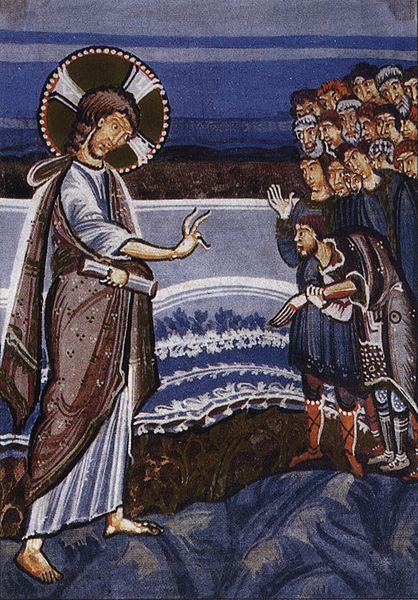
While in a synagogue on the Sabbath, Jesus encountered a man with a withered hand.
The Pharisees were watching closely to see if Jesus would heal on the Sabbath, intending to accuse Him of breaking the Sabbath law.
Jesus asked whether it was lawful to do good on the Sabbath or to harm, and then, in defiance of the Pharisees, He healed the man’s withered hand.
This miracle highlights Jesus’ authority over religious legalism and His commitment to acts of compassion.
16. Feeding the 5,000 (Second Occurrence) (Matthew 15:32-39, Mark 8:1-10):
This is the second account of Jesus miraculously feeding a large crowd, this time involving 4,000 people.
Just as before, with a few loaves of bread and fish, Jesus multiplied the food to feed the multitude.
Seven baskets of leftovers were collected.
This miracle reiterates Jesus’ provision for physical needs and emphasizes His consistency in responding to the people’s hunger.
17. Casting out a Demon from a Boy (Matthew 17:14-21, Mark 9:14-29, Luke 9:37-43):
A desperate father brought his demon-possessed son to Jesus, seeking healing. The disciples had tried to cast out the demon but were unsuccessful.
Jesus rebuked the unclean spirit and healed the boy. He explained that faith as small as a mustard seed could move mountains, emphasizing the importance of faith in performing miracles.
18. Healing the Blind Bartimaeus (Matthew 20:29-34, Mark 10:46-52, Luke 18:35-43):
As Jesus was leaving Jericho, a blind beggar named Bartimaeus cried out to Him for mercy. Despite efforts to silence him, Bartimaeus persisted in calling out to Jesus.
Jesus responded to his faith, asking what he wanted, and Bartimaeus requested his sight. Jesus healed him, saying, “Your faith has made you well.”
This miracle illustrates the power of persistent faith and Jesus’ willingness to respond to the cries of those in need.
